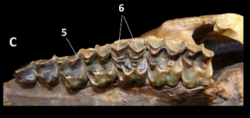Biology:Tetramerorhinus
| Tetramerorhinus | |
|---|---|

| |
| Left lower jaw of Tetramerorhinus mixtum | |
| Scientific classification | |
| Domain: | Eukaryota |
| Kingdom: | Animalia |
| Phylum: | Chordata |
| Class: | Mammalia |
| Order: | †Litopterna |
| Family: | †Proterotheriidae |
| Subfamily: | †Proterotheriinae |
| Genus: | †Tetramerorhinus Ameghino 1894 |
| Type species | |
| †Tetramerorhinus fortis Ameghino, 1894
| |
| Species | |
| |
| Synonyms[1] | |
|
Genus synonymy
T. cingulatum
T. lucarius
T. prosistens
T. mixtum
| |
Tetramerorhinus is an extinct genus of proterotheriid litoptern that lived during the Early and Middle Miocene in what is now Argentina and Peru.[2]
Description
This animal resembled a small horse, with slender, elongated legs. The body was approximately a meter long, and it is supposed to have weighed between 30 and 50 kilograms. The skull had a relatively elongated snout, with nasal bones longer than Diadiaphorus and with less developed upper incisors. The orbits were positioned near the middle of the skull. The molars had lower crowns than those of more derived proterotheriids, such as Proterotherium.[3][4]
The endocranial cast of a specimen of Tetramerorhinus lucarius has been preserved, which allowed to reconstruct certain structures of the animal's brain. The brain was quite large relatively to the size of the skull, due to the development, especially in the anterior part, of the neocortex, and to the complexity of the cerebellum. The olfactory lobes were small and separated by a deep notch, while the cerebellum was elongated and separated from the two cerebral hemispheres by a deep and narrow depression. The rhinencephalon was highly developed, and the piriform lobes were in a much less lateral position than those of archaic ungulates such as Phenacodus, and presented a sort of circular depression of unknown significance. Numerous longitudinal grooves covered the surface of the neocortex. The cranial nerves were unusually arranged relatively to those of other ungulates, and the foramen ovale was posterior to the tentorium osseum.[5]
Classification
The genus Tetramerorhinus was first described in 1894 by Florentino Ameghino, based on fossil remains found in Early Miocene deposits in Patagonia. Numerous species have been ascribed to this genus, such as Tetramerorhinus cingulatum, T. fleaglei, T. mixtum, T. lucarius, T. prosisttens.[6][7]
Tetramerorhinus is a proterotheriid, a group of litopterns with characteristics similar to those of equids, although they were not closely related. Tetramerorhinus seems to have been a derived form, closely related to Anisolophus and Proterotherium.
Below is a phylogenetic tree of the Proterotheriidae, based on the work of McGrath et al. 2020.[8]
| Proterotheriidae |
| |||||||||||||||||||||||||||||||||||||||||||||||||||||||||||||||||||||||||||||||||||||||||||||||||||||||||||||||||||||||||||||||||||||||||||||||||||||||||||||||||||||||||||||||||||||||||||||||||||||||||||||||||||||||||||||||||
References
- ↑ Soria, M.F. (2001). Los Proterotheriidae (Litopterna, Mammalia) : sistemática, origen y filogenia. Monografías del Museo Argentino de Ciencias Naturales. pp. 1–167.
- ↑ Tejada-Lara, Julia V.; Salas-Gismondi, Rodolfo; Pujos, François; Baby, Patrice; Benammi, Mouloud; Brusset, Stéphane; De Franceschi, Dario; Espurt, Nicolas et al. (March 2015). Goswami, Anjali. ed. "Life in proto-Amazonia: Middle Miocene mammals from the Fitzcarrald Arch (Peruvian Amazonia)" (in en). Palaeontology 58 (2): 341–378. doi:10.1111/pala.12147. Bibcode: 2015Palgy..58..341T.
- ↑ Kramarz, Alejandro G.; Bond, Mariano (September 2005). "Los Litopterna (Mammalia) de la Formación Pinturas, Mioceno Temprano-Medio de Patagonia". Ameghiniana 42 (3): 611–625. ISSN 0002-7014. http://www.scielo.org.ar/scielo.php?script=sci_abstract&pid=S0002-70142005000300008&lng=es&nrm=iso&tlng=es.
- ↑ Villafañe, A. L.; Ortiz Jaureguizar, Edgardo; Bond, Mariano (2006). "Cambios en la riqueza taxonómica y en las tasas de primera y última aparición de los Proterotheriidae (Mammalia, Litopterna) durante el Cenozoico" (in es). Estudios Geológicos 62 (1). doi:10.3989/egeol.0662115. ISSN 0367-0449. http://sedici.unlp.edu.ar/handle/10915/40070.
- ↑ Simpson, George Gaylord; Brown, Barnum (1933). "Braincasts of two typotheres and a litoptern.". American Museum Novitates (629): 8–10. https://digitallibrary.amnh.org/bitstream/handle/2246/2054/N0629.pdf?sequence=1.
- ↑ Ameghino, Florentino (1894) (in fr). Énumération synoptique des espèces de mammifères fossiles des formations éocènes de Patagonie. Imp. de P.E. Coni é hijos. https://books.google.com/books?id=nlkrAAAAYAAJ&q=Enumeration+synoptique+des+especes+de+mammif%C3%A8res+fossiles+des+formations+%C3%A9oc%C3%A8nes+de+Patagonie&pg=PA3.
- ↑ Madden, Richard H.; Carlini, Alfredo A.; Vucetich, Maria Guiomar; Kay, Richard F. (2010-06-17) (in en). The Paleontology of Gran Barranca: Evolution and Environmental Change Through the Middle Cenozoic of Patagonia. Cambridge University Press. ISBN 978-0-521-87241-6. https://books.google.com/books?id=oY7wkK6lV4cC&q=A+new+mammal+fauna+at+the+top+of+the+Gran+Barranca+sequence+and+its+biochronological+significance.&pg=PA264.
- ↑ Andrew J. McGrath; Federico Anaya; Darin A. Croft (2020). "New proterotheriids (Litopterna, Mammalia) from the middle Miocene of Quebrada Honda, Bolivia, and trends in diversity and body size of proterotheriid and macraucheniid litopterns". Ameghiniana 57 (2): 159–188. doi:10.5710/AMGH.03.03.2020.3268.
Wikidata ☰ Q3769142 entry
 |

